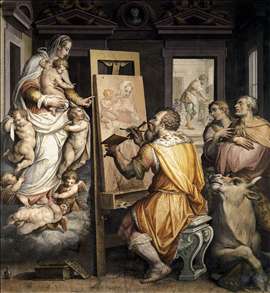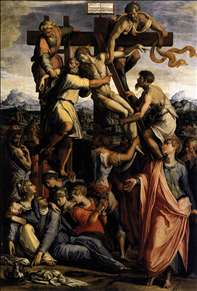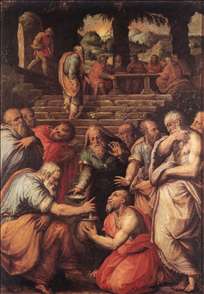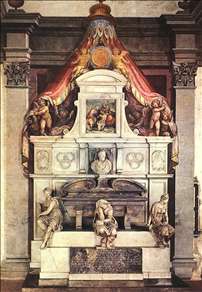Italian painter, architect and biographer. He was born in Arezzo and trained in Florence, in the circle of Andrea del Sarto and his pupils
Rosso and
Pontormo, where, above all, he became a
Michelangelo idolater. He spent his busy and productive life as a painter between Florence and Rome, but he was really a superb impresario rather than a painter himself and perhaps because of his gifts in this direction his work as an architect ranks much higher than his painting.
His principal paintings are in Florence (Palazzo Vecchio frescoes and in galleries) and Rome (Sala Regia in the Vatican and the so-called 100 days fresco in the Cancellaria) as well as in his own house in Arezzo, which is now a museum. He was however, important in the development of Counter-Reformation iconography, as in his Immaculate Conception (SS. Apostoli, Florence), and in elaborate allegories glorifying the Medici Grand Dukes.
As a painter, Vasari was one of the most prolific decorators of his period, but he is not now highly regarded, his work representing the most in-bred and affected kind of Mannerism. As an architect he has a higher reputation; his most important building is the Uffizi in Florence. He designed and decorated his own house in Arezzo. Vasari was also the first important collector of drawings, using them partly as research material for his biographies, for the insight they gave into the creative process.
Vasari s activities as painter and architect have been completely overshadowed by his role as the most important of all artistic biographers. His great book, generally referred to as Lives of the Artists, is not only the fundamental source of information on Italian Renaissance art, but also a key document in shaping attitudes about the period for centuries afterwards. (The book was first published in 1550 as Le Vite de pi eccelenti architetti, pittori, et scultori italiani - The Lives of the Most Eminent Italian Architects, Painters, and Sculptors; in 1568 he published a second, much enlargened edition, in which the painters are mentioned first in the title.)
Vasari wrote with a definite philosophy of art and art history. He believed that art is in the first instance imitation of nature and that progress in painting consists of the perfecting of the means of representation. He accepted the belief of Italian humanism that these had been taken to a high level of perfection in classical antiquity, that art had passed through a period of decline in the Middle Ages, and that it was revived and set once more on its true path by
Giotto. The main theme of the Lives was to set forth the revival of arts in Tuscany by Giotto and
Cimabue, its steady progress at the hands of such artists as
Ghiberti, Brunelleschi, and
Donatello, and its culmination with
Leonardo, Raphael, and above all Michelangelo, whom Vasari idolized and whose biography was the only one of a living artist to appear in the first edition of his book (the second edition includes accounts of several artists then living, as well as Vasari s own auto-biography).
The idea of artistic progress he promulgated subsequently coloured most writing on the period. Although Vasari s testimony has often been impugned on particular points (see for example Andrea del Castagno and Andrea del Sarto ), he gathered together an enormous amount of invaluable information and presented it in a lively style, full of memorable anecdotes. Moreover, his qualitative judgments have generally stood the test of time as well. His book became the model for artistic biographers in other countries, such as
van Mander in the Netherlands, Palomino in Spain, and
Sandrart in Germany.









